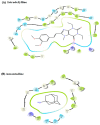Screening of Crucial Cytosolicproteins Interconnecting the Endoplasmic Reticulum and Mitochondria in Parkinson's Disease and the Impact of Anti-Parkinson Drugs in the Preservation of Organelle Connectivity
- PMID: 38002511
- PMCID: PMC10670093
- DOI: 10.3390/brainsci13111551
Screening of Crucial Cytosolicproteins Interconnecting the Endoplasmic Reticulum and Mitochondria in Parkinson's Disease and the Impact of Anti-Parkinson Drugs in the Preservation of Organelle Connectivity
Abstract
Mitochondrial dysfunction is well-established in Parkinson's disease (PD); however, its dysfunctions associating with cell organelle connectivity remain unknown. We aimed to establish the crucial cytosolic protein involved in organelle connectivity between mitochondria and the endopalmic reticulum (ER) through a computational approach by constructing an organelle protein network to extract functional clusters presenting the crucial PD protein connecting organelles. Then, we assessed the influence of anti-parkinsonism drugs (n = 35) on the crucial protein through molecular docking and molecular dynamic simulation and further validated its gene expression in PD participants under, istradefylline (n = 25) and amantadine (n = 25) treatment. Based on our investigation, D-aspartate oxidase (DDO )protein was found to be the critical that connects both mitochondria and the ER. Further, molecular docking showed that istradefylline has a high affinity (-9.073 kcal/mol) against DDO protein, which may disrupt mitochondrial-ER connectivity. While amantadine (-4.53 kcal/mol) shows negligible effects against DDO that contribute to conformational changes in drug binding, Successively, DDO gene expression was downregulated in istradefylline-treated PD participants, which elucidated the likelihood of an istradefylline off-target mechanism. Overall, our findings illuminate the off-target effects of anti-parkinsonism medications on DDO protein, enabling the recommendation of off-target-free PD treatments.
Keywords: Parkinson’s disease; mitochondria-associated membranes (MAMs); mitochondrial-ER; neuroinflammation; systems biology.
Conflict of interest statement
The authors declare no conflict of interest.
Figures






Similar articles
-
Mitochondria-Associated Membranes (MAMs): Overview and Its Role in Parkinson's Disease.Mol Neurobiol. 2017 Oct;54(8):6287-6303. doi: 10.1007/s12035-016-0140-8. Epub 2016 Oct 6. Mol Neurobiol. 2017. PMID: 27714635 Review.
-
Targeting calcium homeostasis and impaired inter-organelle crosstalk as a potential therapeutic approach in Parkinson's disease.Life Sci. 2023 Oct 1;330:121995. doi: 10.1016/j.lfs.2023.121995. Epub 2023 Aug 2. Life Sci. 2023. PMID: 37541578 Review.
-
Mitochondria-Associated Membranes and ER Stress.Curr Top Microbiol Immunol. 2018;414:73-102. doi: 10.1007/82_2017_2. Curr Top Microbiol Immunol. 2018. PMID: 28349285 Review.
-
Organelle-specific autophagy in inflammatory diseases: a potential therapeutic target underlying the quality control of multiple organelles.Autophagy. 2021 Feb;17(2):385-401. doi: 10.1080/15548627.2020.1725377. Epub 2020 Feb 12. Autophagy. 2021. PMID: 32048886 Free PMC article. Review.
-
Mitochondrial and Organellar Crosstalk in Parkinson's Disease.ASN Neuro. 2021 Jan-Dec;13:17590914211028364. doi: 10.1177/17590914211028364. ASN Neuro. 2021. PMID: 34304614 Free PMC article.
Cited by
-
Identification and Verification of Endoplasmic Reticulum Stress-Related Genes as Novel Signatures for Osteoarthritis Diagnosis and Therapy: A Bioinformatics Analysis-Oriented Pilot Study.Biochem Genet. 2025 Jun;63(3):2312-2329. doi: 10.1007/s10528-024-10818-1. Epub 2024 May 11. Biochem Genet. 2025. PMID: 38734758
-
Secretome from iPSC-derived MSCs exerts proangiogenic and immunosuppressive effects to alleviate radiation-induced vascular endothelial cell damage.Stem Cell Res Ther. 2024 Jul 29;15(1):230. doi: 10.1186/s13287-024-03847-5. Stem Cell Res Ther. 2024. PMID: 39075600 Free PMC article.
References
-
- Kouli A., Torsney K.M., Kuan W.L. Parkinson’s Disease: Etiology, Neuropathology, and Pathogenesis. Exon Publications; Brisbane, Australia: 2018. pp. 3–26.
Grants and funding
LinkOut - more resources
Full Text Sources

